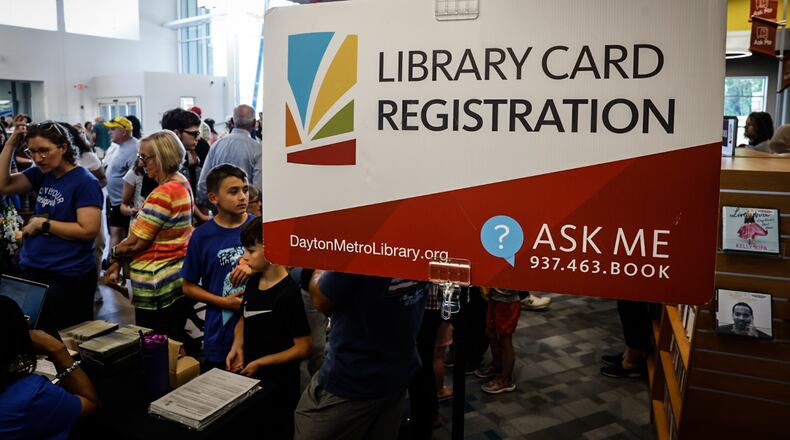The Montgomery County commission on Tuesday approved the library’s 1-mill, five-year levy, planned to go before voters for approval in the Nov. 5 general election.
The levy would not appear on the ballot of districts in Montgomery County with their own library networks, including Germantown, Oakwood and Centerville-Washington Twp.
The library’s board estimated that the levy would generate nearly $10.5 million each year if passed by voters. That would amount to $35 for every $100,000 of property value annually, according to the county.
The last operating levy for Dayton Metro Library was in 2009.
Dayton Metro Library serves 365,000 active cardholders, 71,000 of which are children. The library system saw 1.8 million physical visits at all of its branches and 1.6 million website visits last year.
“We’re internally sort of now referring to our website as our 18th branch because it has become a really popular destination for those who want to learn more about programs and service offerings, but also for those who are making use of electronic resources,” said Trzeciak.
The library has seen historic highs in terms of its content. In 2023, the library hit a record of 7 million items circulated, according to Dayton Metro.
This week, the library also reached 1 million digital downloads, a milestone the library typically reaches every fall.
“The myth of people not using libraries for books is a myth,” Trzeciak said.
But digital resources are also seeing traffic. Last year, its loanable laptop program saw laptops checked out to cardholders more than 300,000 times across all branches. Dayton Metro also has 150 Roku streaming devices available for check-out, a resource that is gaining interest in the community.
Physical copies of books cost the library $17 each on average. But those same books in the form of an e-book cost the library $65 each, whereas audiobooks cost $95.
Roughly 43% of the library’s circulation consists of e-books and audiobooks.
“As more and more people turn to digital as their preferred method, our costs just go up and up to continue to provide them the access they want and need,” Trzeciak said.
In Ohio, public libraries receive state funding through the Public Library Fund. In the state budget, the Public Library Fund gets 1.7% of the state’s general revenue fund. That general revenue fund receives more than two-thirds of its money from sales and income taxes.
Roughly half of Dayton Metro’s revenue this year, or $34.4 million, comes from the Public Library Fund. Another 38% comes from real estate taxes, and the library brought in $1.5 million in gifts and grants.
The Montgomery County Budget Commission, which consists of the county’s auditor, treasurer and prosecutor, last year passed along $25 million in state funding to local libraries. This is down from $26.6 million the prior fiscal year.
Library staff are expecting a loss of $1.6 million in state support by the end of this year.
“And to put that into perspective, that’s the cost of running two of our branches,” Trzeciak said.
Library branches have made $2.6 million in cuts to staffing, hours, facility support and some digital collection items this year.
But even after these cuts, the library is projected to end the year with a $6.8 million deficit.
The library’s board of trustees approved the levy at their July meeting. Last year, Dayton Metro completed its 10-year Libraries for a Smarter Future initiative, which included a system-wide library construction and renovation project. That effort was funded by a $187 million bond issue that voters approved in 2012 with a 62% majority. That money did not cover any costs related to operating expenses.
Montgomery County commissioners on Tuesday applauded the library system for its facilities and services, pointing to community development that happens around libraries.
“This is not your parents’ library that everybody remembers,” said Montgomery County Commissioner Judy Dodge. “It’s always such a bright, cheerful place.”
About the Author

